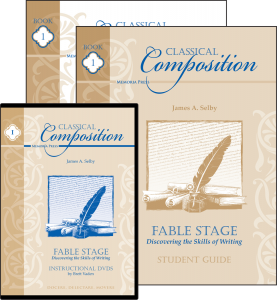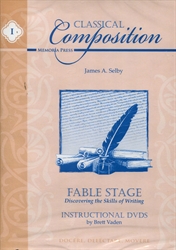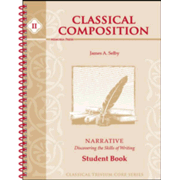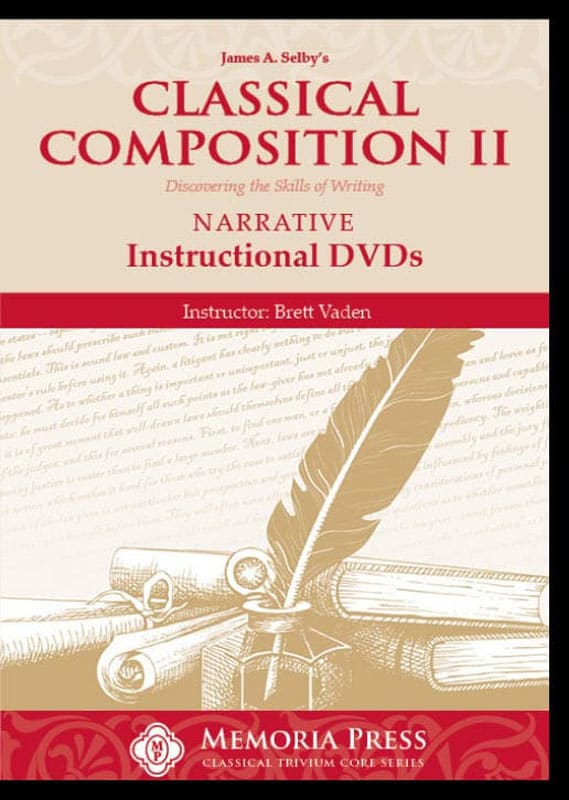In the Classical Composition series, author James A. Selby has resurrected the progymnasmata, the method of teaching composition used by classical educators for more than 1500 years. Students follow a structured approach to learning the various skills for writing and rhetoric. Lessons begin with imitation. Students first learn the skills of narration and paraphrasing, working from given material rather than their own ideas. They gradually begin to develop their own stories, but still based on ideas provided within each lesson. As they continue through the courses, they will eventually develop and present their own ideas.
The art of written communication is taught in stages through the nine courses in this series. The courses are arranged in “stages” through which students should progress in sequence beginning at fourth grade and above. Even older students starting into Classical Composition should begin with the first stage. The stages which are also the subtitles for each course are:
I Fable
II Narrative
III Chreia/Maxim
IV Refutation/Confirmation
V Common Topic
VI Encomium/Invective/Comparison
VII Characterization
VIII Description
IX Thesis/Law
While all levels are available, I received only the first three levels for review. For each level there are a student book and a teacher guide plus optional DVD lesson presentations and lesson plans.
Students in grades four through six will actually complete only about three-fourths of the lessons or fewer in at least each of the first six courses. In subsequent years, they will go back and use the remaining lessons in previous courses for review. A student just starting the series later, such as in eighth grade, will complete even fewer lessons in each book as they work through up to four courses in one year. Each course presents a number of lessons that all follow a similar format, so students should learn the essential skills even with fewer lessons completed. If a student needs more time at a particular stage, it is more important to slow down and complete additional lessons in that course rather than trying to rush through.
The design of each course changes to suit the skills and techniques to be mastered. All levels require presentation by a teacher, although using the optional DVD lessons taught by Brett Vaden will cover much of the teaching. These courses are not for independent study. Some lesson activities that are directed by the teacher are described only in the teacher guide or on the DVDs and not in the student book. The parent or teacher will need to take some time in advance to become familiar with the format of the lesson presentations, but after the first few lessons the courses should be fairly easy to teach.
The teacher guide is essential both for instructions on how to teach each course and as an answer key. It isn’t clear from the teacher guides how long each of the steps of each lesson might take, so I recommend that you get the optional lesson plans or else you will have to figure out how to pace each lesson on your own.
The courses teach the vocabulary of the progymnasmata, teaching and using words such as effictio, chronographia, astrothesia, and geographia to name the figures of description that are an important component of each course. Appendices at the back of each student book and teacher guide include a glossary of the figures of description with examples. While the vocabulary might seem intimidating at first, I expect that both teacher and students will gradually become familiar with the new vocabulary since it is taught with examples, applied within lessons, and revisited in each course.
I Fable
The Fable Stage is based on imitation, working with Aesop’s Fables. Students imitate by applying the techniques of variation and paraphrase. So, rather than writing their own original material, students learn by “reworking” each fable. Each lesson begins with the reading aloud of a fable that will be used throughout the two-week lesson. The teacher guide lists vocabulary words from the story along with definitions. Rather than simply present these for students to learn, the teacher directs an oral discussion regarding these words to help students determine the meanings if they are not already familiar.
Students next listen to the story again to identify examples of “recognition,” “reversal,” and “suffering.” These terms are fully explained in the course, and examples are given in the teacher guide. The teacher will work with students, especially at first, to help them identify these elements. While the DVD lesson presentations are helpful for this step, parents or teachers still need to work directly with students at some points as they develop their own narratives and paraphrases.
Students next work on variations of words and sentences, first finding synonyms for individual words. Then they rewrite the sentences with their new synonyms and/or rewrite sentences with synonyms plus rearrangement or expansion of the sentence elements.
The student book provides a pre-numbered outline form for students to fill in as they outline the original fable. Students then use their own outline to narrate the story either orally or physically without looking back to the original fable.
The next task is for students to write two different paraphrases of the fable. For the first paraphrase students will expand the story by adding “figures of description.” For the second paraphrase, they will either invert or alter the sequence of events in the story or write a “reduction”—a version of the story that eliminates all superfluous elements while retaining the essentials. A second “variations” exercise provides additional work with synonyms and sentence structure. The lesson concludes with students writing a final draft of one of their paraphrases that will be graded with the rubric found in the teacher guide.
II Narrative Stage
The Narrative Stage is quite similar to the Fable Stage but with some differences. The narrative selections that are used for each lesson are drawn from the Bible, from pagan mythology, and from other stories. The styles of writing vary much more than those used in the Fable Stage, so the analysis of each narrative will generally be more challenging. As students write their paraphrases, they repeat usage of the figures of description that were taught in the first course. While students identified “recognition,” “reversal,” and “suffering” in the Fable Stage, they now add six more elements to identify nine components of narrative invention in each narrative piece. At the end of the book are two fable lessons for students who need more practice working at that level.
III Chreia/Maxim Stage
The Chreia/Maxim Stage is noticeably different from the first two levels. Each lesson is built around a brief, one- or two-sentence maxim. Most maxims are from famous Americans or from scripture. For example, one lesson uses the quote from Andrew Jackson: “There are no necessary evils in government. Its evils exist only in its abuses” ( p. 24). Obviously, there is much less material here to imitate than in the lessons in the first two levels. Students will now be doing more of their own writing. Some of it will require research.
The first three parts of the lesson have students identify things they know about the author of the maxim, write an introductory sentence, and write three statements in praise of the author. Students then write a simple thesis statement for their paper. All of this is in preparation for the first of eight paragraphs that will comprise the final paper for each lesson. That paragraph, the “encomium,” includes the introduction, praise of the author (why we should listen to him), and the thesis.
They continue through the lesson writing additional paragraphs, each very tightly controlled for a specific purpose. The next paragraph is a paraphrase. This is followed by a “cause” paragraph that is a general story supporting the maxim. In the “converse” paragraph, students explain what will happen if the maxim is not heeded. For the next paragraph, students create an analogy, and this is followed by an example drawn from a familiar story from scripture, history, or literature. The seventh paragraph requires students to find a quotation from another source that supports the point of the maxim, and this is presented as “testimony.” The “epilogue” paragraph challenges the audience to respond to the truth of the maxim.
Students continue to work on variations and figures of description, and the nine components of narrative invention are used repeatedly through each lesson. Students really need to have completed a number of lessons in the first two courses before tackling this level, since it incorporates many elements that would be totally unfamiliar to those who have not previously been taught in this fashion.
Summary
Classical Composition is a very structured approach for learning writing skills. Its use of pre-selected literary passages and maxims for the early stages contrasts strongly with the creative writing approach commonly taught in the elementary grades. This fits well with the classical education view of the trivium as developmental stages. Children in the grammar stage work on learning skills and vocabulary that will be foundational for creative efforts that will come later. It should work best in situations where two or more children are working together and can share ideas through teacher-led discussion, but it should also work for parents teaching only one child. Even if you use the DVDs, parent or teacher involvement is essential. And those not already familiar with the progymnasmata will be learning right along with their students—which might be a very good thing.
The lessons are certainly more challenging than many other writing resources used in the homeschooling world, but students will likely develop writing skills at a much higher level with these courses.



















